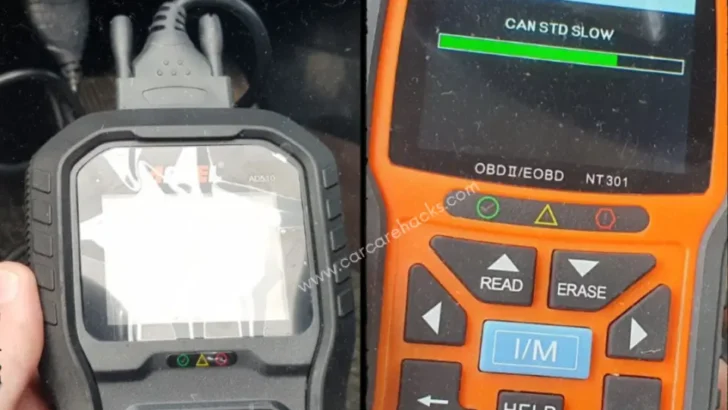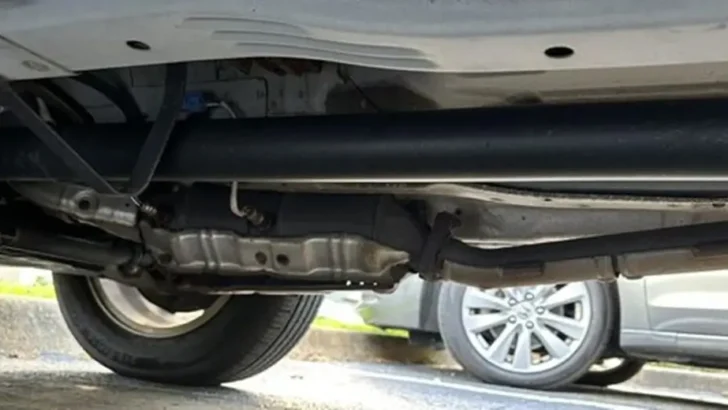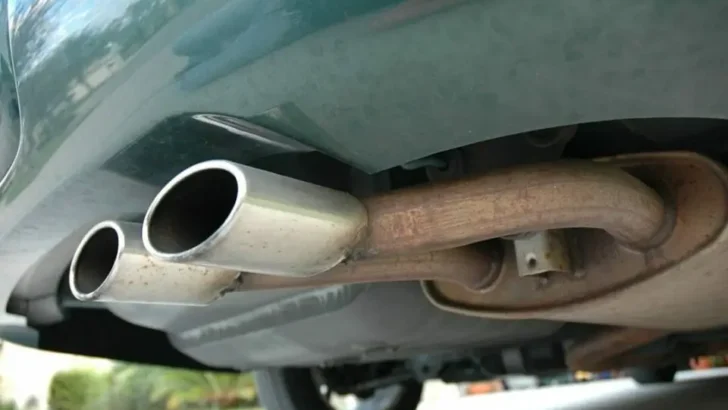If you’re a car owner, encountering diagnostic trouble codes can feel like an unwelcome surprise. The P2097 code indicates an issue with the post-catalytic converter fuel trim system on Bank 1, signaling that things aren’t running as smoothly as they should be.
Let’s dive deep into what this code means, its symptoms, potential causes, and how you can tackle it effectively!
Key Takeaway
The P2097 code signals that the post-catalytic fuel trim system on Bank 1 is running too rich. This means there’s an excess of fuel in the exhaust after it has passed through the catalytic converter.
A rich condition can lead to various issues, including increased emissions and reduced engine efficiency.
Ignoring this warning could result in more significant problems down the line, such as damage to your catalytic converter or decreased vehicle performance.
It’s crucial for car owners to address this issue promptly. Understanding how to identify symptoms and potential causes will empower you with knowledge about what your vehicle needs.
What does the P2097 code mean?
The P2097 code is a diagnostic trouble code (DTC) that indicates an issue with the post-catalytic converter fuel trim system on Bank 1. Essentially, it signals that the engine’s computer has detected a rich condition in this area of the exhaust system.
When we talk about “rich,” we’re referring to an excess of fuel compared to air in the combustion process. This imbalance can lead to inefficient engine performance and increased emissions.
Bank 1 specifically refers to one side of your vehicle’s engine—often where cylinder number one is located. The presence of the P2097 code suggests problems after the catalyst, meaning it relates directly to how well your catalytic converter is functioning regarding fuel management.
What are the common symptoms of a P2097 code?
When your vehicle throws a P2097 code, it often comes with noticeable symptoms. One of the first signs is poor fuel economy. You might find yourself stopping at the gas station more frequently.
Another common symptom is rough engine performance. This can manifest as stalling or hesitation during acceleration, making drives less smooth than usual.
You may also experience an illuminated check engine light on your dashboard. Ignoring this warning could lead to further complications down the road.
Additionally, you might notice increased exhaust emissions. A rich fuel trim means unburned fuel is escaping into the atmosphere, which can raise concerns for both environment and safety.
Strange smells from the exhaust can be alarming too. If you catch a whiff of something unusual when idling or driving, it’s time to investigate further.
What causes a P2097 code?
Several factors can lead to a P2097 code. One of the primary causes is a malfunctioning oxygen sensor. This component measures the exhaust gases and helps determine if the fuel mixture is too rich or too lean.
Another potential issue could be an exhaust leak. If there’s a gap in your system, it can allow excess oxygen into the mix, skewing readings and triggering this error code.
Fuel injectors might also play a role. If they’re delivering too much fuel, it will result in an overly rich condition that activates the P2097 code.
Engine control module (ECM) problems can’t be ruled out. A faulty ECM may misinterpret data from various sensors, leading to incorrect adjustments to fuel trim levels. Addressing these issues promptly can help restore optimal vehicle performance.
How is a P2097 code diagnosed?
Diagnosing a P2097 code involves several key steps. First, a diagnostic scanner is connected to the vehicle’s onboard computer. This tool reads trouble codes and provides valuable data.
Next, technicians will inspect the fuel trim readings for Bank 1. They check if it’s excessively rich compared to specifications. A discrepancy here usually points toward underlying issues.
Visual inspections are crucial too. Mechanics look for damaged wiring or vacuum leaks that could affect engine performance. Any signs of wear or damage can contribute to this error code.
Additionally, they may test components such as oxygen sensors and fuel injectors. These parts play significant roles in regulating air-fuel mixtures.
Road testing can help identify any irregular behavior while driving. Observing how the vehicle responds under different conditions offers further insights into potential causes of the P2097 code.
How do I fix a P2097 – Post Catalyst Fuel Trim System Too Rich (Bank 1) ?
Fixing a P2097 code involves several steps to ensure that your vehicle runs smoothly and efficiently. Start by conducting a thorough inspection of the exhaust system for any leaks or damage, as these can contribute to incorrect readings from the oxygen sensors.
Next, check the fuel trim values with an OBD-II scanner. If they are consistently outside the normal range, you may need to investigate further into fuel delivery issues. This could mean assessing components like the fuel injectors for clogs or malfunctions.
Don’t overlook the importance of inspecting electrical connections leading to both upstream and downstream oxygen sensors. A frayed wire or poor connection can lead to erratic sensor readings that trigger the P2097 code.
If all else fails, consider resetting your engine control module (ECM) after making repairs. Use your OBD-II scanner; if you clear the codes and they return shortly after starting again, it’s time for more in-depth diagnostics.
It may also be wise to consult a professional mechanic if you’re unable to pinpoint or resolve issues on your own. They have specialized tools and expertise that can save you time and prevent potential misdiagnoses.
Addressing a P2097 code promptly is key not just for performance but also for keeping emissions within legal limits – something every responsible driver should prioritize.
How much does it cost to fix a P2097 code?
The cost to fix a P2097 code can vary widely depending on the root cause:
- Oxygen sensor replacement: $150-$300 USD
- Catalytic converter replacement: $500-$2500 USD
- Exhaust leak repair: $100-$400 USD
- Mass airflow sensor replacement: $150-$400 USD
- Fuel injector cleaning/replacement: $200-$600 USD
Are there any other codes that may be related to a P2097 code?
When dealing with a P2097 code, it’s crucial to be aware of other related diagnostic trouble codes :
- P0171/P0174: System Too Lean
- P0172/P0175: System Too Rich
- P0420: Catalyst System Efficiency Below Threshold
- P0430: Catalyst System Efficiency Below Threshold (Bank 2)
Frequently Asked Questions About P2097 – Post Catalyst Fuel Trim System Too Rich (Bank 1) :
Is it safe to continue driving with a P2097 code?
Generally, you can keep driving for a little while, but extended periods on the road might cause harm to the catalytic converter and result in lower fuel efficiency. It’s advisable to get it inspected promptly.
Can I diagnose a P2097 code myself?

Although certain tasks can be performed at home using an OBD-II scanner. However, if things seem complex, seeking professional help is wise to avoid further complications down the line.
What parts might need to be replaced to fix a P2097 code?
When dealing with a P2097 code, several parts could potentially require replacement. The most common culprits often include the oxygen sensors. If these sensors are malfunctioning or reading inaccurately, they can throw off fuel trim calculations.
Another part to consider is the catalytic converter. A failing catalytic converter can lead to excessive emissions and trigger the P2097 code due to improper exhaust flow.
Fuel injectors may also be at fault, particularly if they’re leaking or clogged. This can cause an overly rich fuel mixture that results in diagnostic trouble codes.
Additionally, check for any vacuum leaks around intake components. These leaks disrupt air-fuel ratios and may necessitate replacing gaskets or hoses.
Can a P2097 code clear itself?
A P2097 code typically indicates a persistent issue with the fuel trim system being too rich after the catalytic converter. It often requires intervention for resolution.
In some rare cases, if the underlying problem resolves itself—like a temporary sensor glitch or a momentary fuel quality issue—the code may clear on its own. However, this situation is not common.
It’s crucial to monitor your vehicle closely even if the light disappears. An intermittent fault can lead to recurring problems that might worsen over time.
Relying solely on self-clearing codes without addressing potential issues isn’t advisable. Regular diagnostics and maintenance are essential for ensuring long-term vehicle health.
How can I prevent a P2097 code from occurring?
To prevent a P2097 code from occurring, regular vehicle maintenance is essential. Keep up with oil changes and replace air filters as needed. Clean fuel injectors can also help maintain optimal performance.
Using high-quality fuel plays a significant role in engine health. Avoid low-grade or contaminated fuels that could lead to combustion issues.
Monitor your exhaust system for leaks or damage regularly. Addressing any problems early on can save you from future headaches.
Check the condition of your catalytic converter, as it’s crucial for proper emissions control. If you notice any signs of deterioration, consider replacing it promptly.
Keep an eye on engine performance indicators such as rough idling or poor acceleration; these can signal underlying issues before they escalate into something more serious like a P2097 code.
Is P2097 a generic or manufacturer-specific code?
The P2097 code is classified as a generic OBD-II trouble code. This means it’s recognized across various vehicle makes and models, not limited to any specific manufacturer.
Can a bad catalytic converter cause a P2097 code?

Yes, a bad catalytic converter can indeed trigger a P2097 code. This component plays a vital role in managing emissions and maintaining optimal engine performance.
When the catalytic converter is malfunctioning, it can lead to improper exhaust flow or increased back pressure. Such conditions may disrupt the air-fuel mixture balance that your vehicle’s computer relies on for accurate readings.
As a result, if the fuel trim system detects excessive fuel richness post-catalytic conversion, it will register this imbalance as a P2097 code. The engine control unit interprets this data and signals potential issues with emissions efficiency.
If you suspect your catalytic converter is faulty, it’s essential to have it inspected promptly. Ignoring this issue could lead to more severe damage or costly repairs down the line.
How does an exhaust leak contribute to a P2097 code?
An exhaust leak can significantly impact the performance of your vehicle’s engine. When there is a breach in the exhaust system, it allows outside air to enter. This disrupts the delicate balance between fuel and air that your engine needs for optimal combustion.
As oxygen enters through an unintended gap, it skews the readings from various sensors. The Engine Control Unit (ECU) misinterprets this extra oxygen as a sign that more fuel is needed. Consequently, it adjusts the fuel trim settings incorrectly, leading to a rich mixture at Bank 1.
This incorrect adjustment triggers the P2097 code. It indicates that after passing through the catalytic converter, there’s too much unburned fuel remaining in the exhaust gases. Repairing any leaks not only helps restore proper function but also aids in maintaining emissions standards for your vehicle.
Can using the wrong type of fuel cause a P2097 code?
Using the wrong type of fuel can indeed lead to a P2097 code. When your vehicle is designed for a specific octane rating, using lower-grade fuel can disrupt the combustion process.
This disruption may cause an imbalance in the air-fuel mixture. A rich condition occurs when there’s too much fuel and not enough air in that mix, prompting the engine control module (ECM) to throw a P2097 code.
In addition, lower-quality fuels often contain additives that might affect performance. These impurities can lead to incomplete combustion and increased emissions.
Over time, consistent use of incorrect fuel types could worsen engine efficiency. This cycle further aggravates issues related to catalytic converters as well, leading you down a path where repairs become necessary sooner than anticipated.
How long does it typically take to repair a P2097 code?
The time required to repair a P2097 code can vary widely. Several factors come into play, including the underlying cause of the issue and the vehicle’s make and model.
If it’s a simple fix like replacing a faulty oxygen sensor, it might take just an hour or two. More complex problems, such as exhaust leaks or catalytic converter issues, could extend the repair time significantly.
In some cases, diagnostic tests may be needed before any repairs commence. This adds additional hours to the overall timeline.
Will a P2097 code cause me to fail an emissions test?

A P2097 code indicates that the post-catalytic converter fuel trim system is running too rich on bank 1. This imbalance in your vehicle’s air-fuel mixture can indeed affect emissions.
When a vehicle throws a P2097 code, it suggests inefficiencies within the emissions control system. Emission tests are designed to measure these efficiencies accurately. If your car’s onboard diagnostic system detects this code, you may fail the test.
Moreover, failing an emissions test due to a P2097 can lead to further implications for registration and compliance with local regulations. It’s vital to address this issue before attempting an emission test.
Fixing any underlying problems related to the P2097 code not only helps clear it but also improves your chances of passing inspections without issues down the line. Taking proactive steps ensures that you’re driving a cleaner and more compliant vehicle.
Can weather or altitude affect the occurrence of a P2097 code?
Weather and altitude can indeed play a role in the occurrence of a P2097 code. Changes in temperature or humidity may influence how your vehicle’s engine manages fuel trim adjustments.
In colder climates, for example, engines often run richer to compensate for lower temperatures. This can lead to an increase in fuel consumption and potentially trigger the P2097 code if the system detects excessive richness post-catalytic converter.
Higher altitudes introduce another layer of complexity. Reduced oxygen levels challenge combustion efficiency, leading some vehicles to alter their air-fuel mixture. If this adaptation results in too rich a condition for Bank 1, you might encounter that pesky P2097 code.
Always keep an eye on local weather conditions as well as elevation changes during road trips. These factors could contribute significantly to diagnostic trouble codes related to fuel systems.
Is it possible to clear a P2097 code without fixing the underlying issue?
Clearing a P2097 code without addressing the underlying issue is technically possible, but it’s not advisable. Many vehicle owners may opt for this quick fix, thinking they can simply reset their check engine light and forget about the problem. However, this approach only masks the symptom rather than resolving the root cause.
If you clear the code and continue to drive with an unresolved issue, you risk more severe damage to your vehicle over time. Ignoring a rich fuel trim condition can lead to problems like poor fuel economy or even failure of critical components such as the catalytic converter.
Moreover, many modern vehicles will eventually reactivate the error code if it persists after being cleared. This could result in unnecessary diagnostic costs down the line when you are forced to confront what was initially ignored. It’s always best practice to diagnose and repair any issues indicated by trouble codes like P2097 for optimal vehicle performance and longevity.
